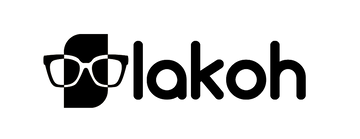Lens Index and Material Guide
When purchasing prescription glasses, understanding the lens index and material is key to making the right choice. At Lakoh, we are dedicated to helping you choose lenses that not only correct your vision but also provide comfort and style. In this guide, we will delve into the details of lens index and how to choose the right lens material for your needs.
What is Lens Index?
The term "lens index" refers to the measure of how efficiently light is bent, or refracted, as it passes through the lens material. This directly affects the thickness and weight of the lenses. The higher the lens index, the more efficiently the material refracts light, resulting in thinner and lighter lenses. Conversely, materials with a lower lens index do not bend light as efficiently, leading to thicker and heavier lenses.
If you're unsure which lens index to choose, don’t worry! At Lakoh, we will recommend the best lens index based on your prescription and personal needs.
Choosing the Right Lens Index
-
1.50 Standard Index Lenses

- Ideal for: Individuals with low to moderate prescriptions (+1.00 to -2.75).
- Features: These lenses have a lens index of 1.50 and are a cost-effective choice. While they are relatively thicker, they offer good optical performance, making them ideal for budget-conscious users or those with lower prescriptions. They are especially suitable for full-rim glasses.
-
1.57 Mid-Index Lenses


- Ideal for: Individuals with moderate prescriptions (+2.00 to -3.75).
- Features: Lenses with a 1.57 index strike a balance between thickness and affordability. They are about 15% thinner than 1.50 standard lenses, offering improved aesthetics and comfort, making them a great option for full-rim glasses.
-
1.61 High-Index Lenses

- Ideal for: Those with higher prescriptions, especially in the range of +3.00 to -5.75.
- Features: Lenses with a 1.61 index are up to 20% thinner than standard lenses, and they are lighter in weight, making them ideal for users who need thinner, lighter lenses. These lenses not only significantly reduce lens thickness but also provide a more comfortable wearing experience, suitable for full-rim, half-rim, or rimless glasses.
-
1.67 High-Index Lenses

- Ideal for: Those with high myopia or hyperopia (in the range of +4.75 to -6.75).
- Features: Lenses with a 1.67 index are up to 30% thinner than 1.50 standard lenses, making them ideal for users who need high vision correction but want to keep the lenses thin and light. These lenses reduce thickness while providing excellent vision clarity and comfort, suitable for full-rim, half-rim, or rimless glasses.
-
1.74 Ultra High-Index Lenses

- Ideal for: Individuals with very high prescriptions, typically in the range of +5.00 to -7.00.
- Features: 1.74 ultra high-index lenses are the thinnest and lightest option available, making them perfect for those who need significant vision correction and want the thinnest possible lenses. These lenses not only reduce the overall thickness but also provide superior visual clarity and comfort, suitable for full-rim glasses.
Lens Material Options
-
CR-39 (1.50 Index)

- Ideal for: Individuals with low to moderate prescriptions; a popular plastic lens material.
- Features: CR-39 is a common optical plastic material known for its excellent optical performance and good scratch resistance. It is the standard choice for lenses with a 1.50 index, offering lightweight construction and cost-effectiveness, making it ideal for budget-conscious users. The main downside of CR-39 is that it tends to be thicker, so it is best suited for lower prescriptions.
-
MR-7 (1.67 Index)
- Ideal for: Individuals with moderate to high prescriptions; a high-index material choice.
- Features: MR-7 is a high-performance lens material known for its excellent optical properties and impact resistance. With a 1.67 index, MR-7 lenses are thinner and lighter, making them ideal for users with higher prescriptions. Additionally, MR-7 lenses are highly durable, making them perfect for everyday wear.
-
Trivex® (1.53 Index)

- Ideal for: Mild to moderate prescriptions (+2.00 to -3.00), especially for children's and sports glasses.
- Features: Trivex lenses are renowned for their impact resistance and clarity. They are lightweight and durable, making them ideal for active individuals who need extra protection. Trivex lenses also provide excellent optical performance and are suitable for all types of frames.
-
Polycarbonate (1.59 Index)

- Ideal for: Prescriptions in the range of +3.00 to -4.75, especially suitable for children's and sports glasses.
- Features: Polycarbonate lenses are known for their impact resistance. They are thin, lightweight, and durable, making them ideal for situations where extra protection is needed, such as sports or outdoor activities. Polycarbonate lenses are also popular for their lightweight construction, making them great for children's eyewear.
Factors Affecting Lens Thickness
- Prescription Strength: The higher the prescription, especially with astigmatism correction, the thicker the lenses will be.
- Lens Material: The lens index determines the thickness of the lens. The higher the index, the thinner the lens.
- Lens Size: The overall width and height of the lens significantly impact its thickness. The larger the lens, the thicker it tends to be. At Lakoh, we help you choose the best frame size and lens thickness based on your prescription.
Conclusion
Choosing the right lens index and material is essential to ensure your glasses are both comfortable and stylish. At Lakoh, we simplify the process by recommending the best options based on your individual needs. Whether you need ultra-thin high-index lenses or durable impact-resistant materials, we have the perfect choice for you.






